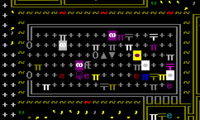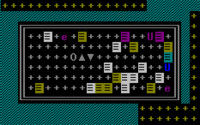- v50 information can now be added to pages in the main namespace. v0.47 information can still be found in the DF2014 namespace. See here for more details on the new versioning policy.
- Use this page to report any issues related to the migration.
Difference between revisions of "Library"
(Subject-verb agreement) |
(Added some info on procedurally generated libraries.) |
||
| Line 13: | Line 13: | ||
* Build [[table]]s and [[chair]]s | * Build [[table]]s and [[chair]]s | ||
* Designate [[scholar]]s and [[scribe]]s as desired (via the [[locations]] ({{k|l}} by default) menu) | * Designate [[scholar]]s and [[scribe]]s as desired (via the [[locations]] ({{k|l}} by default) menu) | ||
| + | |||
| + | ==Adventure mode== | ||
| + | [[File:Humanlibrary_43.PNG|200px|thumb|right|The study area of a human library.]] | ||
| + | [[File:Humanlibrary2_43.PNG|200px|thumb|right|An upper floor of a human library, dedicated to storing the books.]] | ||
| + | Libraries can be found in some procedurally generated sites in adventure mode. In an unmodded game, libraries can be found in human [[town]]s and dwarven [[fortress]]es. Like the libraries in [[fortress mode]], the dittos in adventure mode will be frequented by scholars who spend their days pondering and arguing about [[personality_trait#beliefs|values]]. | ||
| + | |||
| + | The number of books and scholars in a given generated library depends on the history of the site. A library found in a town with a poor history may be almost empty of books and scholars alike. | ||
| + | |||
| + | The ground floor in a generated libray is typically used as a study area, and furnished with chairs, tables and a container with [[quire|writing]] [[scroll|materials]]. A rampcase connects the ground floor to higher floors as well as a basement. Basements and higher floors are typically used to store the [[book]]s, and contain several bookcases. | ||
| + | |||
| + | Libraries found in dwarven fortresses are usually much smaller than those found in human towns, and only have two floors: one study floor on the ground level, and one floor above it containing bookcases. | ||
{{Category|Locations}} | {{Category|Locations}} | ||
{{Category|Adventurer mode}} | {{Category|Adventurer mode}} | ||
Revision as of 10:30, 10 August 2016
v50.14 · v0.47.05 This article is about the current version of DF.Note that some content may still need to be updated. |
Libraries are locations. At a library, scribes can copy books/scrolls and scholars can write them. Dwarves (even those who are not assigned to the library) will sometimes come to read books or idle around.
Scholars of various races will visit your library, often bringing books of their own. Occasionally they will take your books with them when they leave. They may also write their own books while visiting (using your supply of writing material in the process). These books effectively become property of your fortress, as the author usually doesn't take their books away upon leaving.
Setting up a Library
- Hit i to designate the zone for your library. Set it to a meeting area with m, hit l to designate it as a location. See the locations page for more details.
- Build bookcases to store books and scrolls
- Build boxes/bags to store writing material (blank quires and scrolls)
- Build tables and chairs
- Designate scholars and scribes as desired (via the locations (l by default) menu)
Adventure mode
Libraries can be found in some procedurally generated sites in adventure mode. In an unmodded game, libraries can be found in human towns and dwarven fortresses. Like the libraries in fortress mode, the dittos in adventure mode will be frequented by scholars who spend their days pondering and arguing about values.
The number of books and scholars in a given generated library depends on the history of the site. A library found in a town with a poor history may be almost empty of books and scholars alike.
The ground floor in a generated libray is typically used as a study area, and furnished with chairs, tables and a container with writing materials. A rampcase connects the ground floor to higher floors as well as a basement. Basements and higher floors are typically used to store the books, and contain several bookcases.
Libraries found in dwarven fortresses are usually much smaller than those found in human towns, and only have two floors: one study floor on the ground level, and one floor above it containing bookcases.

